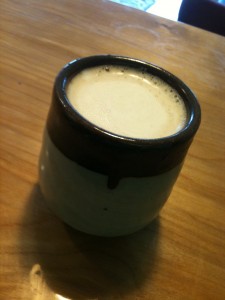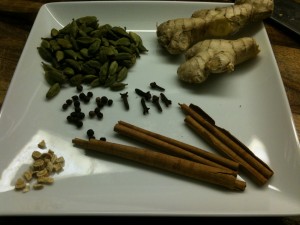It’s wonderful to incorporate as many healing foods into your diet as possible and to include lots and lots of spices and culinary herbs.
Today I’d like to share a favorite Fall recipe to help you do just that. I can’t claim that it’s truly “my” recipe, nor that it’s been passed down to me by a lineage of wise yogis. This is just a masala chai the way that I make it, the way that I like to drink it on cold and cloudy days. I promise it’s better (and much more medicinally potent) than anything you can buy in a coffee shop.
In this recipe I include a small bit of astragalus. Astragalus membranaceus is a wonderful herb to use during cold and flu season to keep your immune system strong. Home-made chai with astragalus is a great way to keep colds and flu at-bay while enjoying some of the season’s best flavors.
Think of this more as a set of guidelines than as a set recipe. Play with the flavors you like best and add different ratios of the spices according to your taste. Make sure to leave the astragalus out if you feel that you’re coming down with something. It has the tendency to drive illness deeper into the body if you consume it when you’re already sick.
Masala Chai (spiced tea)
Masala means “spice” and chai means “tea.” It is redundant to call something “Chai
tea,” no matter what the local coffee joint seems to think.
Ingredients:
- fresh ginger root, peeled (2 large knobs, pictured)
- cardamom pods (1/8 cup, or more to taste)
- black peppercorns (4-7, to taste)
- cloves (whole) 4
- cinnamon sticks 1-2, to taste
- astragalus root, optional (avoid if you feel that you’re coming down with a cold or flu.) 2 tsp
- honey (optional, but recommended)
- ‘milk’ of your choice (recipe for raw cashew milk included—this is what I prefer to use.)
Instructions:
1.) Add your herbs (not including the black tea) to an empty pot and cover with filtered water. For the amount of herbs listed I use a little over a quart of water.
2.) Bring the water up to a rolling boil, then turn the heat down and let it simmer, uncovered, until the water has reduced by half. This is what herbalists call making a decoction. (As you’ll discover when you do this step, there’s a bonus to making your own chai: your kitchen will smell amazing.
3. When the water has reduced by half, add your black tea. I prefer to keep my caffeine consumption low, so I like to make this recipe with the equivalent of 1-2 teabags worth of black tea. You can add more or less as your tastes dictate, or use decaf.
4. The chai is done when the water has taken on a lovely amber color, the cardamom pods have popped open and the cinnamon sticks have swollen with water. After you add your black tea, turn off the heat and allow the tea to steep in the spiced water for 2-5 minutes.
4. Strain the tea. Sweeten it with agave nectar or honey to your taste (the spicer you make it, the more sweetness you may need. Cinnamon, cloves, and black pepper become especially strong when decocted like this, so don’t add too much to your first batch!) Chai is traditionally served with milk. I suggest you avoid the health & ethical problems of dairy and use a commercial almond, hemp, or rice milk—or make your own cashew milk with the recipe below.
Cashew Milk:

Ingredients:
Filtered water (6oz)
Raw cashew butter (1 tbsp)
Blend cashew butter and water in a personal blender (I used a Nutri-Bullet, but any blender will work.) Add vanilla extract for vanilla milk. After it sits it may separate back out—just whirr it in the blender again and it’ll be good-as-new.


